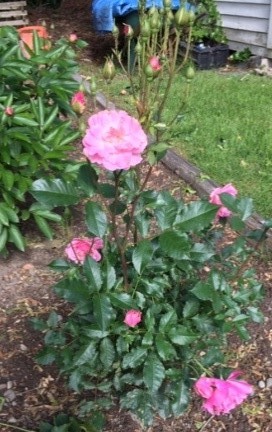Ramblin' Rose
Look around you, it's summer and flowers are blooming everywhere. Some of those flowers have some fascinating stories.
From Wyoming
The other day I was preparing a presentation for Understanding Migration. We, as genealogists, think of Migration as our ancestors, after arriving from their homeland in search of a new life, crossing the country from the East coast to areas across our country. In my search I had found migrating animals and plants, not exactly what I was looking for; I was thinking more like wagon trains. Then a couple days later I was on a virtual meeting with members of the South King County Genealogy Society when we were asked to turn in stories of flowers for the Societies Blog.
Of course, flowers, just read about plant migration in my research
for the presentation.
“I have a Migrating Rose”
Well, here’s the story. We lived in Casper, Wyoming in 1961. My husband, Norv, worked for Supreme Bakers and delivered crackers and cookies around the State of Wyoming. One of his routes was to Worland, Wyoming where a Dr. Horsley lived. Dr. Horsley grew roses, creating new hybrid species. Norv loved roses and often stopped to visit Dr. Horsley to see any new roses he might have created. One day when Norv stopped, Dr. Horsley was creating a new hybrid. Norv became very interested and every trip to Worland, he would stop by Dr. Horsley’s to check on the process. Finally, the rose was registered, named Polsum Bitter. Norv purchased a plant, brought it home and planted it in our rose garden.
In 1966 we moved to Washington State and sold our home in Casper. Before we moved, Norv’s father came over and took the Polsum Bitter rose home to plant in his rose garden.
The first few years we lived in an apartment in Auburn so couldn’t plant any flowers. In 1971 we moved into a house close to Black Diamond. On one of our trips back to Casper we dug up the rose and brought it home and planted it. Since we were moving it from Wyoming to a different climate in Washington, we wondered if it would live; it did and flourished.
Okay, now! When we moved to a home in the Lake Meridian area in Kent, the Polsum Bitter Rose was again dug up and planted at our new home. We lived in that home for seven years and, yes, the rose flourished. My husband and his green thumb get all the credit.
My husband had been watching a new home being built three blocks from where we lived and when the home was finished and on the market, we immediately scheduled an appointment to look at it and had money down on the home by that evening. We didn’t sell the house the first house but used it as a rental for a few years.
The next summer, after living in the new house for a year, Norv went over to the rental and again dug up the Polsum Bitter Rose and brought it to our new house. It is now forty one years later and the Polsum Bitter Rose still flourishes and blooms beautifully each year.
Winona Laird
From South Carolina to Mississippi

The importance of this rose bush to my family is that its predecessor had been brought by my ancestress Mary Hux White when her family migrated in 1810 from Kershaw Co., South Carolina to Wilkinson Co., Mississippi. I have never been able to find out exactly what kind of antique rose it is. It blooms only for a few days in May and does not rebloom until the next year, but it is a visual reminder of my 4th Greatgrandmother and something she loved enough to carry it so far to her new home in the wilderness.
Kathryn Schultz
Down the Valley of Virginia
Meet “Maude”, heirloom rose of the Mayton Family. The story is that she came down the Valley of Virginia with the Mayton Family over 200 years ago. “Maude” has a perfume fragrance with many petals, and blooms once a year. She is a “running” rose; and having been warned, I placed her in a large container. The Mayton family included Revolutionary War veterans Robert Mayton, 1755 -1797, 1st Virginia State Regiment, and his brother-in-law Nathaniel Laffoon, 1745 – 1843, North Carolina Continental Line; Robert’s son John Elmore Mayton, 1775-1846, War of 1812, 2 Reg’t (Bruton's) North Carolina Detached Militia; Robert’s g-g-grandson Jacob Mayton, 1852-1933, said to have been a wagon boy at the Civil War Battle of Chickamauga, TN.
Alexis Hacker Scholz
From Minnesota to Idaho
When my Stowe family came west in 1888, they brought a lot of rootstock from the fruit orchards they had been growing in Minnesota. These orchards flourished in northern Idaho and supported the family for many years.

But another cherished plant was also on board--a rose that has survived and been shared by cuttings throughout the family. This white rose still lives in Coeur d'Alene, just a few blocks from where it was first planted so long ago.
MaryLynn Strickland
Starting a New Tradition
In Salem, Oregon, a cousin grows beautiful roses including one he has rooted from cuttings. The original rose was one he gave his mother on Mother's Day, over thirty five years ago. His mother has since passed away but he keeps her memory alive with this Georgia Pink rose that he has named for her.


Do you have a migrating rose or another flower? Or have you started a new tradition for your family to follow? Take pictures and tell the story of your Ramblin'Rose.







These stories made me take a tour through my memory and roses I have loved. Thank you!
ReplyDelete